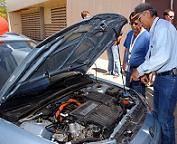Let's See What's Under the Hood...
|
|
Electric Motors and Generators |
These devices are used within a hybrid vehicle in order to harness the electrical energy stored in the battery and move the vehicle [5]. A generator is used to convert mechanical energy into electrical energy. Most hybrid vehicles have generators in order to convert the excess mechanical energy produced by the engine into electrical energy that gets stored in the battery [5]. From here, electrical energy stored in the battery can be used to move the vehicle by means of an electric motor, which does the opposite task of the generator [5]. This method is more efficient since excess energy produced by the engine can be stored and reused at a later time.
Attention:
|
Check out the following link in order to get a better idea of how the various components of a hybrid work together while the car is being driven [5]: Flash Animation: How Hybrids Work |
Regenerative Braking
Regenerative braking is a term used to describe another way in which a hybrid vehicle can be more efficient with energy [5]. It works like this: when the engine (or battery) is used to speed up the car, a certain amount of chemical (or electrical) potential is converted into kinetic energy. But when the vehicle brakes and slows down, this energy is lost to heat (or sound energy if you have an old car and your brakes squeal!). This energy is dissipative, which means that it is lost to the environment of the vehicle. However, there is a more efficient way to deal with this! A regenerative braking system uses a system that allows for some of the kinetic energy lost in braking to be converted into electrical energy that can be stored in the battery and used later [5].
Now that we've looked at some of the inner components of the hybrid vehicle, it is useful to look at some of the ways in which it contrasts with the electric vehicle. Click here to check this out!
 This section will explain how a hybrid engine works and how it is able to use less fuel than a standard gasoline-powered vehicle by talking about some concepts related to hybrid technology such as regenerative braking as well as electric motors and generators. (Photo reproduced with permission from the Los Alamos National Laboratory [
This section will explain how a hybrid engine works and how it is able to use less fuel than a standard gasoline-powered vehicle by talking about some concepts related to hybrid technology such as regenerative braking as well as electric motors and generators. (Photo reproduced with permission from the Los Alamos National Laboratory [